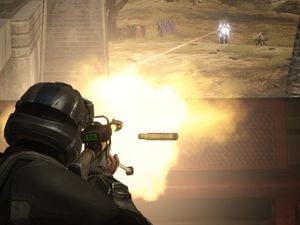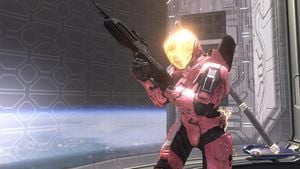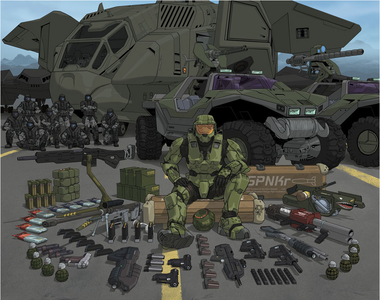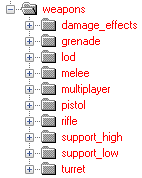Weapon types
From Halopedia, the Halo wiki
This article is part of a series on
Halo gameplay
- Sandbox
- Gameplay mechanics
Heads-up display
Controls
Loadouts
REQs
Spartan abilities
Vitality
Melee
Projectiles
Spread
Aim assist
To check out gameplay articles for other Halo games, see here!
Many different weapons exist across the Halo video games, all of which can be grouped together and classified in numerous ways. The following is an overview of classifications created by or officially recognized by the developers of Halo, and how they affect gameplay.
Weapon Classes
- Main article: Weapon class
Weapon classes are the means by which the Halo video games group together different weapons with similar animations. Characters can only hold weapons belonging to weapon classes supported by their own set of third person animations. Grunts can carry pistols and launchers but not rifles, Marines can carry rifles but not support weapons, and so on. Before being introduced in Halo 2 each weapon required its own set of animations per character. As such Grunts in Halo: Combat Evolved could carry plasma pistols and needlers, but not the human pistol. Weapon classes remove this restriction by having these three weapons share a simplified set of pistol animations. Weapons may still posses unique animation overlays such as an adjusted hand position for the SMG's vertical foregrip or the shotgun's staged reload. Halo Infinite formalized weapons classes as information presented by the user interface. In this context the use of weapon classes describes the intended role of a weapon, combining its appearance with its functionality.
Grenade
Grenades are a form of offensive equipment utilized by players and NPCs[1]. Technically not a weapon themselves according to the Halo game engine, grenades are collected similarly to ammunition and powerups, which can then by thrown as projectiles.
Melee
Melee weapons do not possess firing animations and rely solely on melee attacks. There are two subcategories that exist for players, although more exist exclusive to NPCs.
- Energy Sword[2] - Swords are melee weapons that can perform powerful lunge attacks in addition to dealing increased regular melee damage via the cutting damage type.
- Gravity Hammer[3] - Hammers are melee weapons that create explosions in front of the user without inflicting self harm. The increased physics impulses are also useful for pushing enemies off of ledges, performing splatters with physics objects, and golfing.
Multiplayer
Essentially the same as melee weapons, multiplayer weapons are classified under their own category presumably for organizational purposes. Multiplayer weapons are divided up into two subcategories.
- Ball[4] - Spherical multiplayer weapons held with sports influenced animations, and can also be thrown beginning with Halo 4. Originally comprised of just the oddball, the class now includes the assault bomb, throwable fusion coils, and power seeds.
- Flag[5] - Pole shaped multiplayer weapons used for CTF gamemodes. Flags are dual wielded with magnums in Halo 4 and Halo 5: Guardians.
Pistol
Pistols[6] are projectile weapons held either one handed or with both hands supporting the rear grip. Despite their appearance pistols can possess any level of destructive capability, from the low damage per shot of the plasma pistol to the explosive power of the target locator.
Rifle
Rifles[7] are projectile weapons held with two hands, one hand supporting the barrel from underneath. It is the most common weapon class and has been divided into numerous subcategories.
- Assault Rifle - Mid-ranged weapons lacking scopes, which operate in a niche between tactical rifles and SMGs.
- Tactical Rifle - Mid-ranged, headshot capable weapons featuring magnified optics.
- SMG - Short-ranged weapons with high rates of fire.
- Shotgun - Short-ranged weapons that fire multiple projectiles at once in a spread pattern.
- Sniper Rifle - Long-ranged, headshot capable weapons with high power scopes and considerable damage.
Launcher
Also known internally as "support_high" and "missile" weapons[8], launchers have previously been any weapon carried over characters' shoulders. Halo Infinite now classifies any projectile weapon with explosive damage as a launcher but this does not affect support_high weapons as an animation class.
Support
Also known internally as "support_low" weapons[9], support weapons are any weapon held in first person down by the character's hips. Support weapon animations are very similar to those of the flamethrower from Halo: Combat Evolved, which may have directly inspired the category. Only two support weapons appear in the finalized games, being the brute shot and sentinel beam. Both weapons, along with the class itself, did not return in Halo: Reach, marking Halo 3 as the final appearance of the weapon class. Later appearances of the brute shot and sentinel beam use rifle animations with overlays positioning character arms to hold the weapons in their typical support location. It is because of this reason that Marines in Halo Infinite are able to use the sentinel beam for the first time.
Turret
Detachable turrets[10] are essentially very powerful support weapons that switch the player camera to a third person perspective, do not count towards the player's weapon carrying limit, and restrict certain actions such as crouching, grenades, melee, and equipment. Because of their similar appearances, turret weapons are often called support weapons as well. The data core and power module featured in Invasion use turret animations, and thus its inherent restrictions, to make players more vulnerable while encouraging cooperative play in escorting teammates to objectives.
Damage Types
- Main article: Damage types
In addition to weapon classes, weapons may also be categorized by the type of damage they inflict.
Melee Damage
- Main article: Melee
Most weapons are able to perform melee attacks, but for energy swords, gravity hammers, and multiplayer weapons this is their only means of attack. Some ranged weapons also feature increased melee damage, denoted by slow and heavy animations or by featuring blades and bayonets. The only games to feature ranged weapons with different melee damage types are Halo 2, Halo 3, Halo 3: ODST, and Halo Infinite.
Kinetic 
Being comprised of multiple projectile types such as bullets, spikes, and the impact damage of explosives, kinetic weapons are the most common form of projectile damage. Often times kinetic weapons deal consistent damage against a variety of different materials but usually lack the ability to significantly damage vehicles. In Halo: Combat Evolved and Halo 3: ODST bullet damage is reduced against shields, and in Halo: Reach and the Reclaimer Saga games the sniper rifle deals extra damage against vehicles. In Halo Infinite kinetic weapons can be refilled with kinetic ammo.
Plasma 
Plasma weapons are Covenant or Banished weapons that are very effective against energy shields. While they always deal reduced damage to player health, this trait is not mutually exclusive against the health of other characters. In Halo Infinite plasma weapons can be refilled with plasma ammo.
Hardlight 
Hardlight weapons are Forerunner in origin and disintegrate targets upon inflicting critical damage. Their use differs slightly from game to game. Introduced in Halo 4 they glow orange and possess a damage type similar to the covenant carbine, having no bonus against any material but able to destroy Jackal shields and deployable cover. In Halo 5: Guardians they now deal bonus damage to vehicles and Promethean weakspots. In Halo Infinite hardlight is now purple, can kill vehicle occupants without destroying the vehicle itself, and can be refilled with hardlight ammo.
Shock 
First introduced in Halo Infinite, shock weapons are extremely weak per shot but can chain damage to multiple targets, as well as EMP vehicles. Shock weapons can be refilled with shock ammo.
Headshot Damage

- "Particularly useful against delicate equipment—like brains."
- — Halo: Reach manual description[11]
Precision weapons, sometimes called "anti-materiel" weapons[11], are any weapon capable of instantly killing a character with a headshot. Depending on the character they may not actually have their head region marked as vulnerable and are thus immune, such as Drones in Halo 2 or the Warden Eternal, while other body regions may be marked as headshot vulnerable like the exposed backs of Hunters in Halo: Combat Evolved. In all games prior to Halo 5: Guardians precision weapons will always instantly kill when scoring a headshot on an unshielded enemy, regardless of how much health they had remaining. Halo 5: Guardians introduced weapons with headshot multipliers that deal bonus damage without performing instant kills. In Halo Infinite the shock rifle features a headshot multiplier that still applies while shields are active. With the introduction of these additional headshot parameters the term precision weapon is still used to describe weapons that can kill with a single unshielded headshot. Any form of headshot damage can be applied to kinetic, plasma, hardlight, and shock weapons. Even the impact damage of some explosives can cause headshot damage.
Explosive
Explosive weapons are any weapon or projectile that creates an area of explosive damage. Explosives can also detonate other explosive projectiles and are effected by the explosives support upgrade and grenadier armor mod. In Halo Infinite explosive damage can be applied to kinetic, plasma, hardlight, and shock weapons.
Ammo reserves
The weapons in the Halo series always have a finite amount of ammo, as a way of balancing their power and to encourage the player to scavenge the battlefield. This ammo also cannot be used all at once, and weapons are designed with different ways of handling continuous fire. Ammo reserves are only applied to the player; all NPCs have infinite ammo and never need to reload or vent.
Magazines
The vast majority of weapons in the Halo series divide their ammo reserves in magazines. Magazine size is usually inversely proportional with the weapon's power, and has also been used by the developers to alter the game's balance. Weapons with magazines are reloaded with the appropriate button, and refill the missing ammo in the magazine from their reserves, as long as there is enough ammo in reserve. Ammo reserves of this type of weapons can be replenished by entering in contact with another of its model. Weapons with this type of reload include the vast majority of Human weapons, Promethean weapons, and Covenant weapons based on needles, radioactive ammo, kinetic projectiles, and explosives.
Single Load
A small amount of weapons are loaded bullet-by-bullet. Fully reloading one of these weapons takes much longer than a magazine weapon, but the reload can be interrupted at any time (by opening fire or with a melee attack), leaving the weapon filled with only a part of its full capacity. Like magazine weapons, the reserves of these weapons can be refilled by contact. The first example of this weapon is the Shotgun, but the Hydra also follows this kind of reload. Hardlight weapons in Halo Infinite are reloaded similarly, their magazines refilling in multi-ammo "chunks" over a period of time spent in the reloading animation, but the action can be interrupted partway.
Batteries
Batteries are another way ammo reserves are handled by the Halo series. Battery weapons do not need to be reloaded, but will gradually overheat as one fires, and cool down while not firing. If a weapon reaches a critical temperature, it will stop firing in order to vent the excess heat. In games before Halo Infinite, battery weapons cannot have their reserves replenished by entering in contact with others of their model, and will need to be swapped out. The vast majority of Covenant and Banished plasma weapons have batteries, as well as the Human Spartan Laser and the Sentinel Beam pre-Infinite. In Halo Infinite, the venting of these weapons can be initiated manually.
Finite
A few weapons, usually detached turrets, do not need to be reloaded, and have a finite amount of ammo that cannot be replenished.
Roles
Over the years the Halo community has also created its own terminology based on the way weapons are obtained and used in multiplayer. The following are notable multiplayer weapon terms either created by Halo developers or officially recognized by them.
Loadout Weapon
- Main article: loadout
Loadout weapons, also known as "starter weapons" and "initial weapons"[12][13][14], are weapons given to players at the start of a match and upon respawning[15][16][17][18][19]. Loadouts and starting equipment settings always grant at least a primary weapon, and may also contain a secondary weapon, grenades, and/or equipment. Certain gametypes in Halo: Reach, Halo 4, Halo 2: Anniversary multiplayer, and Halo 5: Guardians offer players a choice of preset loadouts, while Halo 4 also allows players to create up to 5 custom loadouts for use in Infinity gamemodes. Of all weapons that have occupied the loadout role the most common have been the assault rifle, magnum, and battle rifle.
Primary
Primary weapons are comprised of loadout weapons usually belonging to the rifle weapon class[17]. Whenever a match starts or a player respawns, these weapons will immediately be available within the player's hands. An additional primary weapon may also be equipped to any Halo 4 custom loadout given the firepower tactical package is selected.
Secondary
Secondary weapons make up the remaining loadout weapons, typically being pistol class weapons[17]. Secondaries are at the disadvantage of needing to be swapped to after every spawn, and players are unable to equip pistols to their primary custom loadout slot in Halo 4.
Utility Weapon
The Utility weapon is a contentious role, both in terms of gameplay balance as well as the definition of the role itself. Originating from the Halo community and adopted by 343i, utility weapon now officially describes any starting, mid-ranged, scoped, headshot weapon that remains viable both at close and long ranges alike[20][21]. Other weapons are often limited to specific engagement ranges such as the shotgun's close range and sniper rifle's long range, and are less effective or otherwise unusable outside of their intended ranges. While other weapons possess utility functions such as the plasma pistol with its ability to emp shields and vehicles, weapons like the battle rifle instead provide players themselves with utility by allowing them to engage in combat across multiple engagement ranges without the need to switch weapons. This allows players to adopt a "jack of all trades" play style and has led to utility weapons being viewed as essential pickups in multiplayer. For the weapons that have alternative utility functions, they have sometimes been described as "specialized" or "specialist" weapons[22][23]
Dual-wield Weapon
- Main article: dual wielding
Introduced in Halo 2, some weapons can be dual wielded to increase firepower or mixed and matched to create deadly combos without the need to switch weapons. While useful in some circumstances dual wielding is not without its drawbacks. Players cannot melee, throw grenades, or switch weapons without dropping the left hand weapon. Dual wield weapons are typically designed to be weak when used on their own, with plasma weapons having a noticeable decrease in power compared to their Halo: Combat Evolved incarnations. Even the stats of weapons are affected when held in dual wield: accuracy is decreased, damage is nerfed, and the dual wield animations use their own set separate from the weapon class, often resulting in longer reloads. In Halo 2 and Halo 2: Anniversary the penalties to weapon spread activate when both weapons are being fired, and dual wield damage only becomes active when two of the same weapon are fired at once. These two penalties are always active in Halo 3 regardless which weapon combinations are held or when they are firing.
Power Weapon 
Power weapons, which were previously named "heavy weapons" in Halo: Combat Evolved and Halo 2[12][13], are any weapon with the potential to kill fully shielded players with a single shot (or extremely quickly in the case of the flamethrower and SAW)[14][24][25][18][22]. Similarly to dual wielded weapons, the advantage they offer is usually offset by a shortcoming. Slow firing speed, lengthy reloads, and limited range are some of the balancing tools used to prevent multiple one hit kills from occuring simultaneously or in quick succession. Due to their desirability power weapons are usually found at a central spawn location on multiplayer maps. Halo 5: Guardians and Halo Infinite further accentuate this by placing these weapons on marked weapon pads. Despite having its own icon in Halo Infinite power is not a damage type, instead it is displayed to notify players that power weapons can only be refilled with power ammo.
Weapon Sets
Weapon sets are a custom game option used in multiplayer gametypes to replace weapons spawned on the map[12][13][14][24][25][18]. These can be by faction, role, weapon class, damage type, or any other form of organization the developers have made for the game. Some weapon sets also appear as category filters within the forge object library[26][27][28][22]. Below are some examples of common and reoccurring weapon sets.
- Human / UNSC Weapons
- Covenant Weapons
- Forerunner Weapons
- Pistols (Pistol, Magnum, Plasma Pistol)
- Plasma Weapons (Plasma Pistol, Plasma Rifle, Brute Plasma Rifle)
- Dual-wield Weapons (Magnum, Plasma Weapons, Needler, SMG, Silenced SMG, Mauler, Spiker)
- Rifles (Assault Rifle, Plasma Rifle, Battle Rifle, Carbine, DMR, Storm Rifle, Lightrifle, Suppressor, Sentinel Beam)
- Sniping Weapons (Sniper Rifle, Beam Rifle, Focus Rifle, Binary Rifle)
- Heavy Weapons (Launchers, Flamethrower, Detached Turrets)
- Power Weapons (Heavy Weapons, Sniping Weapons, Shotguns, Melee Weapons, SAW)
Power Level
Tiers, also known as power levels, are a categorization method utilized by Halo 5: Guardians which scales weapons by lethality. This also generally serves as a measurement of desirability, informing players to grab higher level weapons in order to become more effective damage dealers in multiplayer and warzone. Power level is also represented by a point system in warzone. Players can requisition more destructive weapons via the points they have accumulated during the warzone match.
Tier 1

- "Basic starter weapons"
- — Halo 5: Guardians forge description[22]
- Loadout Weapons
- Plasma Rifles
- Sentinel Beam
Tier 2

- "More specialized weapons"
- — Halo 5: Guardians forge description[22]
- Shotguns
- Plasma Pistol
- Needler
- Melee Weapons
- Grenade Launchers
- Hydra
Tier 3
- "Power weapons"
- — Halo 5: Guardians forge description[22]
- Launchers
- Sniper Rifles
- SAW
- Detached Turrets
Weapon Variants
Introduced in Halo 2, weapon variants are based on preexisting weapon designs but have received slight statistical and visual changes.
Common Variants
Some variants have little deviation from their parent weapon but are nonetheless considered their own unique asset. Weapons such as these have even made appearances without their original counterparts. Examples include the Brute Plasma Rifle, Silenced SMG, Automag, and Bandit.
REQ Variants
 This section needs expansion. You can help Halopedia by expanding it.
This section needs expansion. You can help Halopedia by expanding it.
Legendary Variants
 This section needs expansion. You can help Halopedia by expanding it.
This section needs expansion. You can help Halopedia by expanding it.
Sources
- ^ Halo 2 Editing Kit, game file
tags\objects\weapons\grenade\frag_grenade\frag_grenade.projectile - ^ Halo 2 Editing Kit, game file
tags\objects\weapons\melee\energy_blade\energy_blade.weapon - ^ Halo 3 Editing Kit, game file
tags\objects\weapons\melee\gravity_hammer\gravity_hammer.weapon - ^ Halo 2 Editing Kit, game file
tags\objects\weapons\multiplayer\ball\ball.weapon - ^ Halo 2 Editing Kit, game file
tags\objects\weapons\multiplayer\flag\flag.weapon - ^ Halo 2 Editing Kit, game file
tags\objects\weapons\pistol\magnum\magnum.weapon - ^ Halo 2 Editing Kit, game file
tags\objects\weapons\rifle\battle_rifle\battle_rifle.weapon - ^ Halo 2 Editing Kit, game file
tags\objects\weapons\support_high\rocket_launcher\rocket_launcher.weapon - ^ Halo 2 Editing Kit, game file
tags\objects\weapons\support_low\brute_shot\brute_shot.weapon - ^ Halo 3 Editing Kit, game file
tags\objects\weapons\turret\machinegun_turret\machinegun_turret.weapon - ^ a b Halo: Reach, manual
- ^ a b c Halo: Combat Evolved, Custom game options
- ^ a b c Halo 2, Custom game options
- ^ a b c Halo 3, Custom game options
- ^ Halo: Reach, Invasion
- ^ Halo: Reach, Firefight
- ^ a b c Halo 4, Infinity (mode)
- ^ a b c Halo 2: Anniversary, Custom game options
- ^ Halo 5: Guardians, Warzone
- ^ Halo Waypoint, Halo 5 Weapon Tuning Test (Retrieved on Sep 19, 2017) [local archive] [external archive]
- ^ Halo Waypoint, Halo Infinite Ranked Competitive Reveal (Retrieved on Dec 7, 2023) [archive]
- ^ a b c d e f Halo 5: Guardians, Forge object library
- ^ Halo Support, Halo Infinite Weapon, Equipment, and Vehicle Inventory (Retrieved on May 5, 2023) [archive]
- ^ a b Halo: Reach, Custom game options
- ^ a b Halo 4, Custom game options
- ^ Halo: Reach, Forge object menu
- ^ Halo 4, Forge object menu
- ^ Halo 2: Anniversary, Forge object menu
| |||||||||||||||||||||||||||||||||||||||||||||||||||||||||||||||||||||||||||||||||||||||||||||||||||||||||||||||||||||||


